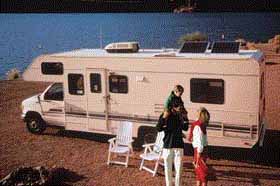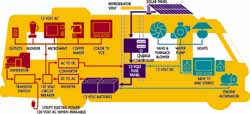Give yourself the power to go anywhere
with the most powerful charging systems under the sun.
 Many people who choose RV Solar Electric
systems are looking for a way to have dependable electricity even when parked
far from the closest plug-in. The reason people give for being happy with
an RV solar system is because it is quiet, or because it is less expensive
and less complicated than a generator.
Many people who choose RV Solar Electric
systems are looking for a way to have dependable electricity even when parked
far from the closest plug-in. The reason people give for being happy with
an RV solar system is because it is quiet, or because it is less expensive
and less complicated than a generator.
Since batteries are charged when traveling, RV's normally depend mostly
on the vehicle's alternator for the primary power source. Power to charge
the battery bank is also provided through a converter when plugged into
the utility. However, for those who like to spend days, weeks (or longer)
not traveling and not plugged in, photovoltaics can mean freedom. And, because
a PV array can put as much power into your batteries during an hour of bright
sun as a small gasoline generator, it can also mean reclaiming peace and
quiet. As well, the RV's existing battery bank and fuse box make the transition
to solar a smooth and economical one.
While most of our RV systems utilize 1 to 3 modules, it is important to
analyze your power needs. Just as with all PV systems, you need to consider
the wattage of the appliances and lights you are powering as well as the
average hours used each day. Average daily usage can be calculated on the
worksheets in the appendix. Unlike most other systems, however, RV's travel
through different regions of climate, park at varying angles to the sun,
sometimes in shad e and sometimes not. People with similar vehicles can
have very dissimilar power usage and patterns of travel. These factors should
be considered. If you have any questions about how to go about this, please
give us a call.
Most of our RV systems are sized to power average daily loads in average
conditions. Determine where you will spend the most time "boon-docking"
for three days or more and in what season. Find this on the map of sun-hours
and make this your "available-sun-hours" entry on the worksheet. If the
modules are mounted flat on the roof, they will put out about 70 percent
as much as if aimed perfectly at the noon-day sun, so multiply sun hours
by .7 for your worksheet entry.
 Some of our customers have chosen to
install an extension cord for their modules so that they can park in the
shade while the array sits in the sun. For added durability and ease of
handling, the "lite" modules on page 34 can be used. Ask us for tips on
this type of arrangement.
Some of our customers have chosen to
install an extension cord for their modules so that they can park in the
shade while the array sits in the sun. For added durability and ease of
handling, the "lite" modules on page 34 can be used. Ask us for tips on
this type of arrangement.
Air conditioners require a very large array and are seldom powered by PV.
Microwaves are okay, but require an inverter as do any other 110 volt AC
appliances. When sizing, don't forget heater blower fans if you use them.
Refrigerators that run on both propane and electric are very inefficient
when run on electric. Any kind of electrical resistance heat is out, with
the exception of occasional hair blowers or toasters.
| WCubed 3775 Encinal Cyn Malibu, CA 90265 |
Phone # (310) 589-9544 Fax # (310) 589-9714 |
